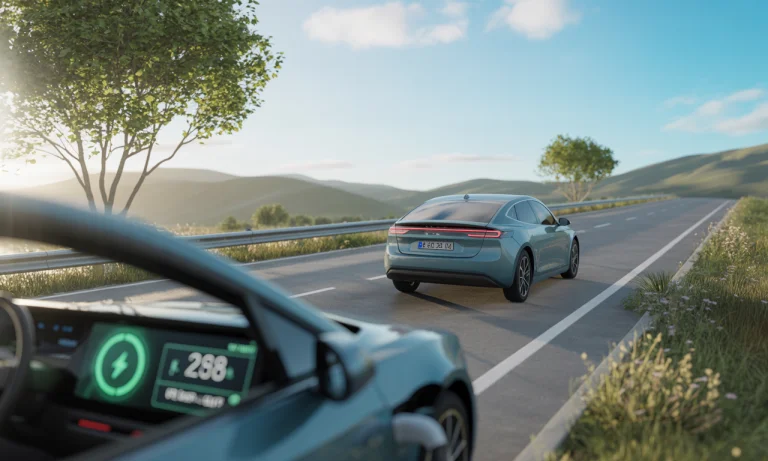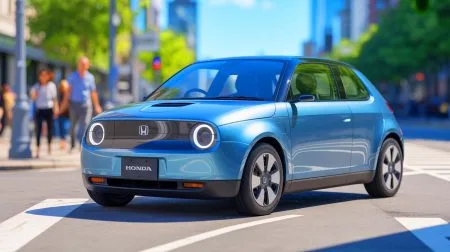Picture a world where your daily drive is not dictated by the nearest gas station but by the silent hum of innovation under your wheels. The electric vehicle revolution has redefined road trips and daily commutes, largely thanks to advancements in battery and charging technology. Today, a single charge can propel some of the most sought-after models—think Tesla, Lucid, and Porsche—distances that seemed inconceivable just a decade ago. Yet, the question persists in every potential buyer’s mind: how far can you truly go on that single, precious charge? From cold winter mornings in Berlin to cross-state adventures in California, your real-world range is a tapestry woven from battery size, weather patterns, terrain, and even your own driving style. The latest data, manufacturer promises, and personal anecdotes intersect to paint a new picture: range anxiety is fading, replaced by practical planning and genuine excitement. This is the new normal parents, adventurers, and daily grinders quietly embrace every time they power up and slip behind the wheel.
Electric Car Driving Range in 2025: What Can You Expect?
For years, concerns about the limited range of electric vehicles shaped the market. But step into a dealership today and the story is drastically different. Most modern EVs now deliver between 250 and 350 miles on a single charge, making worries about getting stranded rarer than ever. Take the Lucid Air: drivers can travel up to 520 miles thanks to an enormous battery and cutting-edge efficiency. High-end models from Tesla—reaching well over 400 miles—or crowd favorites like Ford Mustang Mach-E and Chevrolet Bolt (clocking in at more than 250 miles per charge) are rewriting expectations for everyone, from urban commuters to long-distance travelers. Even brands like Hyundai and Kia have entered the ring with competitive, high-range offerings, while Volvo shatters old boundaries with next-gen batteries.
Still, advertised range is often an ideal scenario. In real life, weather extremes, heavy loads, or racing down the autobahn can nibble away at your expected distance. For instance, pushing a Porsche Taycan to its limits on hilly terrain yields different results than a leisurely city commute in a Nissan Leaf. Yet, today’s figures reveal that EVs can easily cover most users’ daily and even weekly needs. And with public charging networks expanding rapidly, journeys that once looked daunting now feel routine.
| Model | Advertised Range (Miles) | Real-World Average (Miles) | Main Advantage |
|---|---|---|---|
| Lucid Air | 520 | 480 | Unmatched range |
| Tesla Model S | 405 | 380 | High-tech & fast-charging |
| Chevrolet Bolt | 259 | 240 | Affordable & practical |
| Ford Mustang Mach-E | 312 | 290 | Family-friendly SUV |
| Hyundai Ioniq 5 | 303 | 280 | Fast charging |
| Kia EV6 | 310 | 285 | Sporty design |
| Audi e-tron GT | 238 | 215 | Luxury comfort |
| Porsche Taycan | 282 | 250 | Performance |
Understanding What Influences Your Electric Car’s Range
Chris, a young architect from San Francisco, once believed range claims were simple marketing. But after a winter road trip through the Sierra Nevada in his BMW i4, the nuances became crystal clear. Range is a dance of battery size, driving style, terrain, and the elements themselves. His car went 40 miles less than expected, the cold sapping precious capacity. Back at sea level, the numbers rose again, mirroring official figures.
Speed matters, but so does restraint. Gentle acceleration and steady speeds yield significant range bonuses—while speeding, overuse of air conditioning, or tackling mountain roads will drain the battery faster. Meanwhile, manufacturers like Tesla and Audi have invested massively in software that learns your habits, suggesting the most efficient routes or when to ease off the pedal. For more insights on making your car last longer and perform better, check the practical tips at this resource.
If you want to dig deeper into maximizing range, there are additional strategies to explore: maintaining correct tire pressure, using eco-driving modes, or simply planning ahead. Today’s drivers can control their own range fate more than ever before.
The Charging Equation: How Fast Can You Really Get Back On The Road?
When Sasha, a rideshare driver in Boston, switched to a Nissan Ariya, she worried more about charging downtime than distance. But the evolution of charging infrastructure has transformed user experience. Most EVs can now be recharged overnight at home using Level 2 chargers—often providing enough power for a week of standard city use. For cross-country treks, DC fast-chargers, standard on highways and at supermarkets, add up to 200 miles in roughly thirty minutes. Some charging stops start to feel less like an obligation and more like a pitstop for coffee and a quick email check.
Different brands, from Kia to Chevrolet, are now leveraging network maps and route planners to ease drivers’ minds. Your car can predict when and where to charge based on real-time navigation. If you need a primer on preparing your vehicle and home for charging, resources such as this comprehensive guide are invaluable allies. Fast charging is not just a technical marvel—it’s a lifestyle shift.
| Charging Level | Typical Charging Speed | Application |
|---|---|---|
| Level 1 (120V) | 3-5 miles/hour | Home, overnight |
| Level 2 (240V) | 20-30 miles/hour | Home/public, daily use |
| Level 3 (DC Fast) | 100-200 miles/30 min | Public, long trips |
Real-World Range Stories: Balancing Manufacturer Claims and Everyday Life
Numbers on a specs sheet are one thing; the story out on the open road is another. Journalist Maya Roberts tested a Hyundai Kona Electric from downtown Chicago through icy winds to Detroit. Despite the EPA’s 258-mile estimate, her brisk pace and frequent heat blasts meant she rolled into Ann Arbor with just 17 miles left. Meanwhile, city drivers in Los Angeles, rarely venturing far or dealing with extreme conditions, often see real ranges matching or even exceeding official estimates.
It’s clear that parameters fluctuate—sometimes dramatically. To make better decisions, a comparison of official versus actual real-world range has become a staple for enthusiastic buyers. For more details on which EV accessories or habits will make your car journeys smoother, this selection comes highly recommended.
For those worried about the learning curve, EVs now supply data-rich feedback, encouraging drivers to adapt and improve. Tech like predictive range meters, shared across brands from Porsche to Ford, closes the expectation gap and boosts confidence.
The Electric Car Range Revolution: Innovations and What’s Next
The journey for more mileage isn’t over—far from it. The industry’s horizon is shaped by solid-state batteries, lightweight construction, improved aerodynamics, and smart energy recovery systems. Companies such as Tesla and Lucid are already piloting new cell chemistries promised to deliver up to 30% more range within the next product cycles. Other brands—including BMW, Audi, and Porsche—are fiercely competing to integrate fast-charging tech and smarter battery management systems. Some researchers even dream of battery swapping becoming mainstream—imagine rolling into a station, swapping a depleted battery for a fresh one, and driving off in minutes.
Public charging infrastructure, now dense in urban areas and highways, has made electric long-haul journeys practical and—sometimes—remarkably comfortable. Meanwhile, regulatory pushes like stricter efficiency standards and clean energy incentives are accelerating these advances globally. For more context on how car tech is impacting safety features, you can visit here, or for a glimpse into self-driving and futuristic services, the insights from this page are illuminating.
Choosing Among Top Electric Cars: Finding the Sweet Spot for Your Needs
With so many options on the market, matching the right EV to your lifestyle is both easier and more nuanced than ever. City dwellers may happily opt for the nimble Mini Electric or a Smart EQ fortwo, while road warriors might lean towards the long-range Lucid Air or Tesla Model S. Families or those needing more space find SUVs from Hyundai, Kia, and Ford (see more models here) incredibly versatile, blending comfort and competitive range. Pricing, available incentives, and your own travel patterns all come into play.
It’s a market where innovation shows no sign of slowing—every new model tips the expectation scales a bit higher, whether it comes from legacy automakers or disruptive newcomers. That means your choice today remains relevant for years, and new software updates or improved charging standards can prolong a vehicle’s usability well into the future. For more help on picking the right car and avoiding classic mistakes, see useful advice at this guide or tips to protect your investment at this page.
FAQ: Everything You Want to Know About Electric Car Range
How long will most electric car batteries last before needing replacement?
Under proper care, the majority of modern EV batteries last between eight and ten years—some even longer with reduced degradation, thanks to new thermal management and charging protocols.
Can weather really affect my EV’s range that much?
Yes—cold can reduce range by 20% to 40% due to battery chemistry and extra heating needs, while hot weather can also slightly degrade performance because of cooling requirements.
Do all public charging stations offer the same speed?
No—charging rates vary between Level 2 (slower, suitable for overnight use) and Level 3 (fast DC charging), with capabilities depending on both the vehicle and network provider.
What steps can I take to maximize the distance I get from each charge?
Drive gently, avoid rapid acceleration, keep tire pressure at optimal levels, use eco mode, limit use of heat and AC, and install software updates as provided by your carmaker.
Should I worry about long road trips with an electric car in 2025?
With dense fast-charging networks and improved ranges, planning a long road trip is easier than ever. Route planning tools and real-time navigation integrated into most new models make cross-country journeys smooth and predictable.
Did you like it? 4.6/5 (20)







